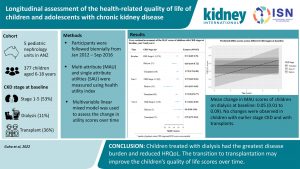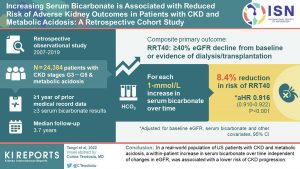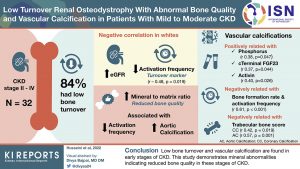Jul 2023 Edition

Impact Factor 2022
Kidney International® presents a selection of recently published articles on the prevention, early identification and intervention of chronic kidney disease (CKD).
KIDNEY INTERNATIONAL ARTICLES |
Perspectives on Early Detection Of Chronic Kidney Disease: The Facts, the Questions, and a Proposed Framework for 2023 and Beyond
CKD is a growing global health burden, whether measured by financial cost, mortality, morbidity, or other indices. According to the Global Burden of Disease survey, CKD is the world’s third-fastest-growing cause of death; approximately 10% of the world’s population lives with CKD. It is expected to be the fifth greatest cause of death by 2040.
The authors have developed a framework for three disputed issues involving CKD early detection: Is early CKD detection a wise use of resources? What are the criteria that make early detection a viable policy option? And, what is the most effective technique for maximizing benefits while reducing harm?
Challenges and Opportunities in Interventions for Chronic Kidney Disease of Unknown Origin (CKDu): Report From the International Society of Nephrology Consortium of Collaborators on CKDu
Chronic kidney disease of unknown origin (CKDu), a tubulointerstitial nephritis reported in agricultural communities (notably, Sri Lanka, Central America, and Southern India), was discovered two decades ago. What causes CKDu? Many theories have been proposed, such as heat stress, environmental toxins, and genetic predisposition, but its pathophysiology remains unclear.
Many questions remain unanswered. More studies are required to elucidate risk factors, explain the current hypotheses on its pathophysiology, and implement therapeutic strategies to help the affected individuals and their communities.
In this paper, the International Society of Nephrology Consortium of Collaborators on CKDu summarizes published studies on CKDu. It discusses the study design, ethical, and cultural challenges and concerns that must be considered for future research in this field.
Effects of Aspirin on Cardiovascular Outcomes in Early Chronic Kidney Disease
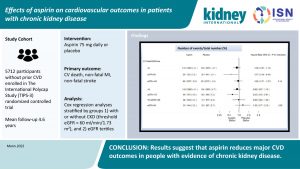 Cardiovascular disease is a leading cause of mortality in end-stage kidney disease patients and non-dialysis-dependent CKD patients. Low-dose aspirin use has been instrumental in deterring cardiovascular events, disease burden, prevention, and mortality.
Cardiovascular disease is a leading cause of mortality in end-stage kidney disease patients and non-dialysis-dependent CKD patients. Low-dose aspirin use has been instrumental in deterring cardiovascular events, disease burden, prevention, and mortality.
Altered platelet function is seen in CKD, which increases the incidence of thromboembolic events and bleeding risk. However, aspirin has favorably affected CKD patients regarding ischemic stroke and cardiovascular mortality.
The next steps attempt to extend trials to include patients with GFR <30 and kidney failure with and without renal replacement therapy.
Longitudinal Assessment of the Health-related Quality of Life of Children and Adolescents With Chronic Kidney Disease
Children with CKD face numerous challenges that can significantly impact their health-related quality of life (HRQoL). CKD often requires lifelong medical interventions, including frequent hospital visits, medication regimens, and dietary restrictions, which can disrupt normal childhood experiences. The physical symptoms of CKD, such as fatigue, pain, and growth delays, can further hinder a child’s well-being and social interactions. Emotional and psychological effects, including anxiety and depression, are also common.
This work from Australia by Guha et al. follows the trajectories of HRQoL in children with CKD over time. A total of 377 children (aged 6-18 years) with CKD stages 1-5 (pre[1]dialysis), dialysis, or transplant were followed biennially for four years. Multi Attribute Utility (MAU) scores of HRQoL were measured at baseline and at two and four years using the McMaster Health Utilities Index Mark 3 tool. A multivariable linear mixed model was used to assess the trajectories over time in 199 children with CKD stage 1-5: 43 of whom were receiving dialysis and 135 of whom were kidney transplant recipients.
The results show that in transplanted children, HRQoL improved over time, and those with stable early CKD which did not progress had a stable HRQoL.
Recent publications in Kidney International Reports® discuss the prevention, early identification and intervention of CKD.
KIDNEY INTERNATIONAL REPORTS ARTICLE |
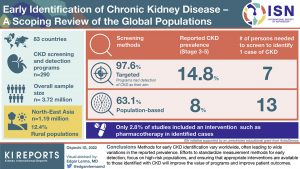 Except for CKD, the burden of noncommunicable diseases such as ischemic heart disease, stroke, and obstructive pulmonary disease has decreased during the last decade. Early detection of CKD necessitates the development of distinct techniques tailored to various cultures, regulations, and environmental factors. Screening procedures and preventive interventions are still hotly discussed topics. Ikechi G. Okpechi, Adeera Levin, Vivekanand Jha, and colleagues discuss
Except for CKD, the burden of noncommunicable diseases such as ischemic heart disease, stroke, and obstructive pulmonary disease has decreased during the last decade. Early detection of CKD necessitates the development of distinct techniques tailored to various cultures, regulations, and environmental factors. Screening procedures and preventive interventions are still hotly discussed topics. Ikechi G. Okpechi, Adeera Levin, Vivekanand Jha, and colleagues discuss
the facts, questions, and a recommended strategy for early diagnosis of CKD for the years 2023 and beyond.
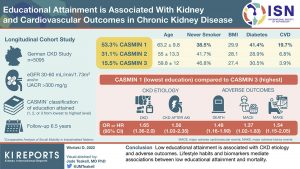 The level of education has a pivotal role in overall morbidity and mortality in a population. Education is a crucial social determinant of health, which varies significantly among individuals with chronic diseases. Educational attainment affects career choices, finances, developing healthy dietary and lifestyle choices, and much more. All these factors affect the overall disease morbidity and mortality in a population.
The level of education has a pivotal role in overall morbidity and mortality in a population. Education is a crucial social determinant of health, which varies significantly among individuals with chronic diseases. Educational attainment affects career choices, finances, developing healthy dietary and lifestyle choices, and much more. All these factors affect the overall disease morbidity and mortality in a population.
The effects of a lower level of education are reflected in poorly controlled chronic diseases like diabetes, hypertension, and other modifiable risk factors like smoking, alcohol consumption, and injudicious use of medications such as analgesics.
In this study conducted by the German CKD cohort, real-life conditions were meticulously accounted for when determining cardiovascular and chronic kidney disease burden. Interestingly, this study was potentiated with objective lab values like CRP, HDL, uric acid, NGAL, and NT-proBNP.
In addition to lifestyle measures, educational attainment had an inverse relationship with MACE, kidney failure and mortality risks. Patients with a lower educational level had increased adverse outcomes. Such studies reveal the social disparities affecting health outcomes and recognize sectors that require change or reinforcement when making health policies.
Metabolic acidosis is a common complication of advanced CKD, and lower serum bicarbonate levels are related to an increased risk of CKD progression. This association has been demonstrated in previous studies, but most of them only consider the measurement of serum bicarbonate at a single point in time. What about serum bicarbonate changes over time? Could they be related to adverse kidney outcomes? To answer these questions, Tangri et al. performed a retrospective analysis of a cohort of patients with CKD stages G3 to G5 and metabolic acidosis, and they found that the increase in serum bicarbonate over time was associated with a low risk of the composite kidney outcome (≥ 40% decline in eGFR or evidence of dialysis or transplantation) with an 8.4% risk reduction per 1mmol/l increase in serum bicarbonate over time.
In this article, the authors highlight the economic burden of CKD in a transitional country. They present data from a study involving 221 patients from Uddanam, a high CKD-burden region in India, with stage IV CKD.
Despite a commitment to providing universal health coverage (UHC) to the population, outpatient care for chronic disease management, including CKD, remains excluded from the ambit of UHC in this region.
In this study, most patients (75.6%) belonged to the upper-lower socioeconomic status category with a median annual household income of US$ 2468.7. Costs for CKD care services were catastrophic for 149 patients (67.4%) at the 10% yearly household income threshold. Eighty-six patients (39%) engaged in distress financing.
The authors argue, “Given that the far greater number of patients with earlier stages of CKD will not need dialysis, the neglect of the economic burden of these patients who are left to seek care from private facilities on their own represents a major failure of the principles of the universal health coverage that will continue to push households into impoverishment.”
They suggest that early detection and evidence-based management of CKD and universal free access to essential medicines for patients with kidney diseases will help alleviate the burden of CKD on patients and populations.
Renal osteodystrophy is a condition that commonly occurs in patients with CKD and is characterized by alterations in bone metabolism and mineralization, resulting in bone pain, fractures, and deformities. Vascular calcification (VC) is a common complication in CKD, arising from imbalanced mineral and hormone levels, inflammation, and oxidative stress. This process leads to the hardening and narrowing of blood vessels, impairing blood flow and increasing the risk of cardiovascular events. Both conditions tend to occur at later stages of CKD.
This paper by El-Husseini et al. evaluates the presence of both conditions in patients with early CKD. The authors use a combination of imaging, tissue diagnosis, and biomarkers to establish diagnoses. Mean estimated glomerular filtration rate was 44 in the group studied, 84% had low bone turnover, and >80% had VC.
This is one of few studies to show that low bone turnover and VC are predominant in the early stages of CKD and has implications for the use of early preventative therapies for both conditions

